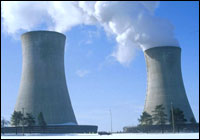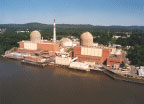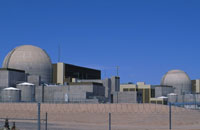Roughly 40 miles from the rubble of the World Trade Center, U.S. Navy cutters patrol the chilly waters of the Hudson River. Military planes circle overhead. On the ground, members of the National Guard stand ready. The Indian Point nuclear power station, which churns out electricity to nearly 2 million homes around New York City, is defended by land, sea, and air.
Yet many people — and especially people in the small town of Buchanan, N.Y., where the power station is located — still worry that terrorists could turn Indian Point into a nuclear bomb, with devastating consequences for New York City and surrounding areas. That fear is not unfounded. Since the terrorists attacks of Sept. 11, the U.S. government has given several indications of credible threats to the nation’s nuclear power plants. For example, on Jan. 23, U.S. intelligence agencies issued an internal alert about a planned attack on a nuclear power plant by Islamic terrorists; six days later, President Bush revealed in his State of the Union address that diagrams of U.S. nuclear plants were found at terrorist bases in Afghanistan.

Feeling insecure?
Although fears — and warnings — that terrorists might attack nuclear facilities have intensified since Sept. 11, they are hardly new. Critics say the Nuclear Regulatory Commission has done little over the years to enhance security at nuclear plants, many of which are located within 50 miles of metropolitan areas. Instead, in the past few years, the nation’s 103 commercial nuclear reactors have been cutting expenses, including security costs, to compete in the new world of electricity deregulation.
At the same time, the nuclear industry is enjoying enthusiastic White House support. Nuclear energy currently supplies about 20 percent of the nation’s electricity, but the Bush administration would like to see that number increase dramatically. The Department of Energy has proposed streamlining the approval process for new nuclear power plants and Bush’s 2003 budget includes funds to match private-sector spending on new plant development. “It is in our nation’s national interest that we develop more energy supplies at home,” Bush told business leaders in late October. “It is in our national interest that we look at safe nuclear power.”
Those Other Twin Towers
But can nuclear plants be made safe from terrorism? There are no rules requiring atomic plants or waste facilities to be secured against large truck bombs or air attacks — the M.O.s of the Oklahoma City bombing and the 1993 and 2001 attacks on the World Trade Center.

Indian Point’s twin reactors.
Photo: Entergy Nuclear.
“If the American Airlines jet that traveled down the Hudson Valley en route to the Twin Towers had instead banked a left turn into one of Indian Point’s twin reactors, the resulting disaster would have been even more horrific than the World Trade Center catastrophe,” said Robert F. Kennedy, Jr., lead attorney for Riverkeeper, one of several environmental groups asking the NRC to close Indian Point. Because of the prevailing southerly winds in the Hudson Valley, a meltdown or major radioactive release at Indian Point “could result in death and chronic radiation sickness for thousands, if not tens of thousands, of the region’s citizens and render much of the New York metropolitan area permanently uninhabitable,” Kennedy said in a press statement.
A 1982 study commissioned by the NRC offers some more specific numbers. According to the study, a worst-case-scenario meltdown at Indian Point 3, one of the plants three reactors, would result in up to 50,000 non-cancer radiation deaths, up to 14,000 cancer deaths, and up to 167,000 cases of radiation-related health problems. A 1997 report for the NRC concluded that a severe release from a nuclear waste storage pool could cause as many as 143,000 deaths and $566 billion in damage, in addition to rendering 2,790 square miles of land uninhabitable. The NRC has never studied how much radiation could be released if an airplane-turned-bomb sparked a jet-fuel fire in a reactor core or nuclear waste storage facility. If firefighters were unable to put out the blaze for several days — as was the case when the graphite core at Chernobyl burned in the Ukraine — much more radiation could be released.
Costs of Cutting Costs
The U.S. nuclear industry claims that both the probability of a successful attack and the scope of the resulting devastation are exaggerated by environmentalists who want to hobble the resurgent atomic sector. Nuclear plants are built with layers of backup safety systems, making it difficult to actually break enough equipment to cause a radioactive release. Reactors in the United States are encased in 180-foot-tall concrete vessels with steel-lined walls that are at least three feet thick. “In security parlance, they are hardened targets,” said Mitch Singer, a spokesman for the Nuclear Energy Institute, the lobbying arm of the atomic power industry. “They are not going to be the ones terrorists go after because [a successful attack] would be too difficult.”
But given that the unthinkable has already happened once, calm assurances from nuclear-energy advocates don’t set everyone’s mind at ease. Critics say nuclear plants cannot compete with low-cost coal and natural gas fuels without cutting costs, including security expenses. And they are skeptical that the NRC will require tougher security unless Congress mandates it. After Sept. 11, the NRC announced a “top-to-bottom review” of its security requirements, but the nuclear industry has been lobbying the agency to move slowly on implementing any new rules. Days after the deadliest terrorist attack ever on U.S. soil, a high-level NRC manager reportedly said nuclear power plants should be allowed to return to normal security levels because of the high cost to utilities. The agency continues to “recommend” that nuclear plants remain on high alert because of FBI concerns about another domestic terrorist attack. But NRC Chair Richard Meserve confirmed in the trade journal Inside NRC that industry lobbyists have made “entreaties” to some NRC staffers to “adjust the security levels downward.” (Singer of the Nuclear Energy Institute denied the group has “made any specific requests to lower security.”)
“The majority of [NRC] managers — even some of the commission — think we’re overreacting in the security area, even now,” said one NRC senior staffer. “The feedback we got from high up in the federal government after Sept. 11 was there are two agencies in the federal government that just don’t get it. One was the FAA [Federal Aviation Administration], and the other was the NRC.”
Guard Doody
Given these attitudes, it’s not surprising that the nuclear power industry and the NRC are trying to kill legislation that would federalize guards at nuclear power plants and impose strict and expensive security regulations on nuclear utilities. The Nuclear Energy Institute, which has given at least $444,000 to Republicans and $171,000 to Democrats in the last five years, is leading the campaign against bills that would make security guards federal employees. In November, Sens. Hillary Rodham Clinton (D-N.Y.), Joe Lieberman (D-Conn.), Harry Reid (D-Nev.), and Sen. Jim Jeffords (I-Vt.) introduced the Nuclear Security Act of 2001. Democratic Reps. Ed Markey (Mass.) and Nita Lowey (N.Y.) proposed similar legislation in the House.

Time to get off the fence.
In response, Joe Colvin, NEI’s president and chief executive officer, called the legislative proposals “a reflexive political response to a problem that does not exist, given the fact that nuclear power plants are private facilities protected by a paramilitary force of highly trained, well-armed dedicated professionals.” NRC Chair Meserve said creating a federal guard force would require hiring 7,000 new government employees to “address a nonexistent problem. … There have been no failures in nuclear plant security of the type that has plagued the commercial airline industry and thus no need for such radical change.”
It’s true that as yet there have been no major failures in nuclear plant security in the U.S., but in security drills conducted by federal regulators, nuclear power plants and airlines have fared equally poorly. Nearly 50 percent of nuclear plants in the country have failed NRC security drills during the past decade — even when guards had at least six months to prepare and knew the day and time the mock terrorists were attacking. Out of the 57 plants tested in “force-on-force” drills by the NRC between 1991 and 1998, 27 showed “significant” weaknesses, meaning a real attack could have resulted in a partial or complete meltdown of the reactor core. In 14 cases, radiation could have been released into the atmosphere.
Advocates of federalizing security forces at nuclear plants say uniform hiring practices would improve safety standards. Currently, these security forces vary from site to site in training, skills, pay, and size. At some plants, guards must run an obstacle course within a time limit with more than 100 pounds on their backs. At other plants, guards simply must be able to climb one flight of stairs — without a time limit.
“There’s big disparities between plants where you have Marine-type training programs and ones where you just have to be alive,” said Dave Lochbaum, a nuclear engineer with the Union of Concerned Scientists. “Federalization would at least require some standardization over educational and physical requirements.” In addition, Lochbaum said some guards make as little as $9 an hour. “At the money they’re paying, the only people they get are people that don’t get the jobs as greeters at Wal Mart,” he said.
Federal rules require that at least 10 guards are on duty at all times at nuclear plants. But the NRC makes exceptions, allowing as few as five guards if plants install barriers, block doors, and take other defensive measures. “If you only have five responders and you’re trying to cover four sides of a plant, that’s going to be tough,” said one NRC senior security staffer. “So numbers do count.”
One reason for the relaxed staffing standards is that guards are only required to defend against a team of three invaders and one insider in NRC drills. The Nuclear Security Act of 2001 would require guards to repel up to 20 attackers working in multiple teams with the active assistance of several plant employees. Rep. Markey said, “The reality is they could come in large numbers, they could be suicidal, they could have sophisticated technical backgrounds, and they could have much greater insider help than previously anticipated.”
Part Two: U.S. nuclear power plants fail the test

